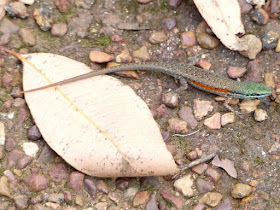This posting concludes a three-part series which explores 'empty' (or at best unhelpful) but laudatory names of
organisms. Why? Well, partly just for fun, and partly to meet some
plants and animals which we may not otherwise have done. Interestingly
mammals for the most part seem not to have inspired such names.
For
translations of these words I'm relying on my friend and colleague
Jeannie Gray, co-author with me of Australian Bird Names
, of which we're
currently working on a new edition. I'm using her work in that book
for nearly all of these names.
concinnus/a - elegant, neat
One of the beauties of such names for a taxonomist is that they can be applied as readily to animals as to plants!
 |
Musk Lorikeet Glossopsitta concinna, Coles Bay, Tasmania.
The eucalypt was a street tree, Eucalyptus ficifolia from Western Australia. |
 |
Southern Pyrgomorph Grasshopper Monistria concinna, Kosciuszko NP, New South Wales.
Posing neatly on Prostanthera cuneata. |
 |
Red Comb Grevillea, Grevillea concinna, Cape Le Grande NP, Western Australia.
|
 |
| Trim Greenhood Pterostylis concinna, Calala, south coast New South Wales. |
nobilis - noble
And a change of tone now, to a more dramatic name.
 |
Bismarck Palms Bismarckia nobilis, southern Madagascar.
Nothing too discreet about Otto von Bismarck, first Chancellor of the German Empire. |
 |
| Christmas Bells Blandfordia nobilis, Currarong, south coast NSW. |
 |
| Yellow Tails Ptilotus nobilis Family Amaranthaceae, far northern South Australia. |
 |
Bearded Mountaineer Oreonympha nobilis at Nicotiana flowers, Huaycarpay, southern Peruvian Andes.
This exotic tobacco tree seems to be helping sustain populations, which occur only in a very small
area of the Andes. Moreover some authorities believe the populations on opposite slopes represent
separate species, as is the case for quite a few hummingbird species-pairs. |
gracile - graceful, slender
Another more 'gentle' subjective adjective (though less subjective if the 'slender' translation is used). We have 'graceful' representatives of three different Kingdoms here!
 |
| Slender Pitcher Plant Nepenthes gracilis, Sabah, Malaysian Borneo. |
 |
Little Laughing Leek Orchid Prasophyllum gracile, Gathercole NR, Western Australia.
I think this little orchid needs all its 'grace' to bear that English name!
|
 |
Smooth Cage, or Basket Fungus Ileodictyon gracile, growing in our front yard;
we assume that the spore came with mulch, but unfortunately it hasn't reappeared.
In this case it is 'graceful' by comparison with the other member of the genus, which is much chunkier. |
 |
Carlia gracilis Slender Rainbow-Skink, south of Darwin, Northern Territory.
|
 |
Elliot's Storm Petrels Oceanites gracilis, Galápagos.
These undeniably graceful little birds are the only storm petrels in the world to regularly
feed in harbours, at least in the Galápagos, 'pattering' in the water to briefly anchor themselves
in place while they harvest tiny animals.
|
 |
Grey Teal Anas gracilis, Jerrabomberra Wetlands, Canberra.
Probably the most abundant Australian duck, though unlike the more familiar
Pacific Black Duck it eschews town ponds and picnic areas. |
Despite my comments above, quite a few 'graceful' mammals exist, most of them being small rodents and South American marsupials.
Well that's the terminus of our journey to explore some of the ways that taxonomists found to imprecisely express their admiration for organisms, and ever more importantly of course to celebrate the animals themselves. Back next time for something completely different.
NEXT POSTING THURSDAY 1 NOVEMBER
(And
remember that you can get a reminder when the next post appears by
putting your email address in the Follow by Email box in the top right
of this screen.
And I'd love to receive your comments - it's easy and you don't need to sign in!)














No comments:
Post a Comment